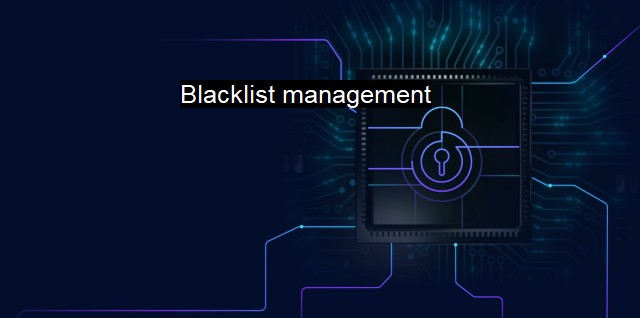What is Blacklist management?
Exploring the Role of Blacklist Management in Ensuring Cybersecurity and Antivirus Software: A Comprehensive Overview
Blacklist management is an essential protective tool designed to improve the safety and integrity of computer systems and networks. A blacklist is essentially a list that includes entities that are to be denied or prevented access because they are deemed as threats. These entities can be IP addresses, URLs, applications, or even emails that exhibit a harmful pattern or suspicious behavior.Blacklist management is the process of keeping this list updated and ensuring that it accurately covers all potential threats. A blacklist might indeed be populated through recognized threat databases or security vendors, through observed patterns of suspicious behavior, or through direct identification of malicious activity. A given entity – IP, URL, email, or a program – once blacklisted, is automatically denied access or halted in its tracks whenever it tries to interact with a protected system or network.
One of the significant utilities of blacklist management is in the sphere of antivirus systems. A standard operating procedure for all antivirus programs is the referencing to a blacklist of identified malware, viruses, trojans, and other cybersecurity threats. This list assists the antivirus in promptly recognizing malicious activity and taking the necessary action. Antivirus software relies heavily on blacklist management as it helps in the quick scanning of potential threats ensuring thereby the system's protection.
Blacklists are dynamic and will need constant updating. The terrain of cybersecurity threats is ever-changing and evolving. The threats that were pertinent yesterday may have been replaced with new ones today. There might be modifications in the malware signatures, or the advent of zero-day exploits. Therefore, effective blacklist management in the realm of cybersecurity and antivirus is continual and reliant on real-time threat information.
This places a significant requirement on providers of blacklists to continually source, update, and distribute these lists in keeping with the latest threat perception. Blacklist management is, thus more than just a repository - it's an active, perpetually updating tool that stays always on top of the latest virus, malware, spam, or phishing threats.
Blacklist management also involves optimization to avoid false positives. Sometimes an IP address, URL, or an email might get wrongfully flagged as a threat, leading to its inclusion in the blacklist. This inclusion may result in unnecessary access denial, interfering with the regular network operations. Thus also, blacklist management necessitates a comprehensive mechanism to validate accusations before putting an entity on the list, to preclude the chances of false positives.
a cautionary point derives from the fact that while blacklist management has its merits, relying solely on it for security and protection can be detrimental. The proactive identification and blocking of threats serve a vital purpose in threat prevention, but it is not absolutely foolproof. Savvy cyber attackers often find ways to circumvent blacklists and infiltrate the system.
Given the rapid pace of the development of new threats, there is always a lag between the time a new threat emerges and the time it gets identified and added to the blacklist. During this time, systems are vulnerable to attack. So, blacklist management must be complemented with other security tools and measures.
Greylisting times the gap that might leave a system prone to an attack. Whitelisting, on the other hand, only allows recognized and safe entities to access the system. These methods can plug the gaps left by blacklist management, providing robust layers of security.
Blacklist management is an indispensable facet of cybersecurity and antivirus defense strategy. It empowers organizations to stop known threats before they cause harm effectively. for maximal effectiveness, it demands meticulous updating, validation and supplementation with other security strategies.

Blacklist management FAQs
What is blacklist management in cybersecurity?
Blacklist management in cybersecurity is the process of maintaining a list of known malicious IP addresses, domains, or URLs that are blocked by anti-virus software, firewalls, or other security solutions to prevent them from accessing your network or compromising your systems.What are the benefits of implementing blacklist management?
Implementing blacklist management helps to reduce the risk of cyber-attacks and data breaches by preventing access to known malicious entities. It also enhances your overall cybersecurity posture and mitigates the impact of potential threats.How do you update the blacklist?
The blacklist is updated regularly by cybersecurity experts who monitor and analyze the latest threats and add the new malicious entities to the list. Some security solutions also use machine learning and artificial intelligence algorithms to automatically identify and block suspicious traffic.What are the best practices for blacklist management?
The best practices for blacklist management include regularly updating the list, using multiple sources to gather threat intelligence, configuring your security solution to automatically block blacklisted entities, and regularly reviewing and refining your blacklist based on the changing threat landscape. It's also important to ensure that legitimate traffic is not blocked by mistake.| | A | | | B | | | C | | | D | | | E | | | F | | | G | | | H | | | I | | | J | | | K | | | L | | | M | |
| | N | | | O | | | P | | | Q | | | R | | | S | | | T | | | U | | | V | | | W | | | X | | | Y | | | Z | |
| | 1 | | | 2 | | | 3 | | | 4 | | | 7 | | | 8 | | |||||||